英语时态8种基本时态讲解
英语时态8种基本时态讲解.ppt课件

8.过去完成时 表示动作发生在过去某一时间之前已经完成的动作或状态, 强调“过去的过去”, 常与 by the time, by the end of…,before , by 等引导时间的状语连用。
基本结构 主语+ had + 动词过去分词 + 其他成分 When I got to the cinema yesterday the film had begun already. He had learned English before he came here.
现在完成时与一般过去时的区别: 1)现在完成时侧重于对现在的影响;而一般过去时侧重于某一动作发生在过去某个时间或某段时间。即现在完成时侧重于现在的结果,而一般过去时侧重于动作发生的时间。例如:
I have seen the film. 我看过这部电影。(现在我仍记得电影的内容) I saw the film three days ago. 三天前我看了这部电影。(强调是三天前,而不是别的什么时候看的电影)
be going to含有“打算,准备”的意思,而will则没有这个意思, She is going to lend us her book. He will be here in half an hour.
be about to+V.原形(意为马上做某事,在时间上指最近的将来) I am about to leave school. 不能与表示时间的副词连用。 They are about to set out.(√) They are about to set,变y为i加-ed. study----studied carry----carried cry----cried try----tried d)以元音字母+y结尾的单词直接加-ed. play----played stay----stayed
英语中常见的八种基本时态
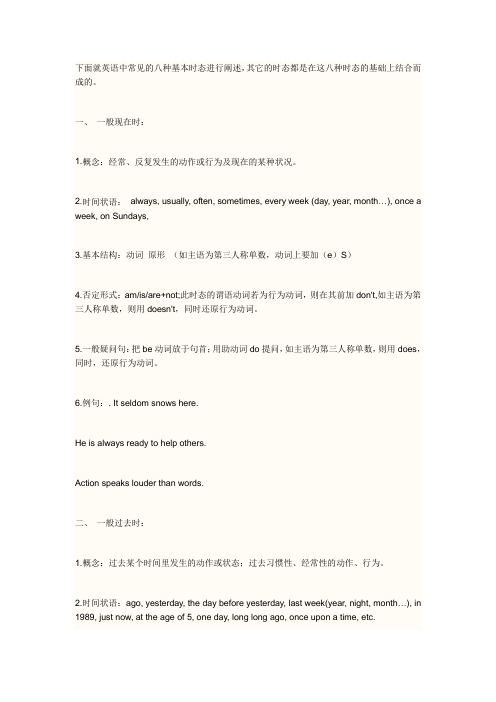
下面就英语中常见的八种基本时态进行阐述,其它的时态都是在这八种时态的基础上结合而成的。
一、一般现在时:1.概念:经常、反复发生的动作或行为及现在的某种状况。
2.时间状语:always, usually, often, sometimes, every week (day, year, month…), once a week, on Sundays,3.基本结构:动词原形(如主语为第三人称单数,动词上要加(e)S)4.否定形式:am/is/are+not;此时态的谓语动词若为行为动词,则在其前加don't,如主语为第三人称单数,则用doesn't,同时还原行为动词。
5.一般疑问句:把be动词放于句首;用助动词do提问,如主语为第三人称单数,则用does,同时,还原行为动词。
6.例句:. It seldom snows here.He is always ready to help others.Action speaks louder than words.二、一般过去时:1.概念:过去某个时间里发生的动作或状态;过去习惯性、经常性的动作、行为。
2.时间状语:ago, yesterday, the day before yesterday, last week(year, night, month…), in 1989, just now, at the age of 5, one day, long long ago, once upon a time, etc.3.基本结构:be动词;行为动词4.否定形式:was/were+not;在行为动词前加didn't,同时还原行为动词。
5.一般疑问句:was或were放于句首;用助动词do的过去式did 提问,同时还原行为动词。
6.例句:She often came to help us in those days.I didn't know you were so busy.三、现在进行时:1.概念:表示现阶段或说话时正在进行的动作及行为。
(完整版)英语常用的八种时态
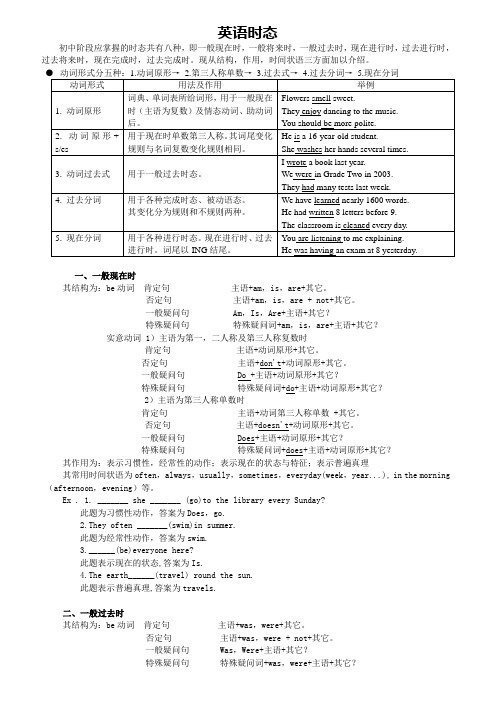
英语时态初中阶段应掌握的时态共有八种,即一般现在时,一般将来时,一般过去时,现在进行时,过去进行时,过去将来时,现在完成时,过去完成时。
现从结构,作用,时间状语三方面加以介绍。
一、一般现在时其结构为:be动词肯定句主语+am,is,are+其它。
否定句主语+am,is,are + not+其它。
一般疑问句 Am,Is,Are+主语+其它?特殊疑问句特殊疑问词+am,is,are+主语+其它?实意动词1)主语为第一,二人称及第三人称复数时肯定句主语+动词原形+其它。
否定句主语+don't+动词原形+其它。
一般疑问句 Do +主语+动词原形+其它?特殊疑问句特殊疑问词+do+主语+动词原形+其它?2)主语为第三人称单数时肯定句主语+动词第三人称单数 +其它。
否定句主语+doesn't+动词原形+其它。
一般疑问句 Does+主语+动词原形+其它?特殊疑问句特殊疑问词+does+主语+动词原形+其它?其作用为:表示习惯性,经常性的动作;表示现在的状态与特征;表示普遍真理其常用时间状语为often,always,usually,sometimes,everyday(week,year...), in the morning (afternoon,evening)等。
Ex . 1. _______ she _______ (go)to the library every Sunday?此题为习惯性动作,答案为Does,go.2.They often _______(swim)in summer.此题为经常性动作,答案为swim.3.______(be)everyone here?此题表示现在的状态,答案为Is.4.The earth______(travel) round the sun.此题表示普遍真理,答案为travels.二、一般过去时其结构为:be动词肯定句主语+was,were+其它。
8个初中英语时态

8个初中英语时态8个初中英语时态是学习英语语法的重要组成部分,以下是它们的定义和例句:1. 现在一般时态:表示现在的动作或状态。
例如:I eat an apple every day. (我每天吃一个苹果。
)2. 过去一般时态:表示过去的动作或状态。
例如:She studied English last year. (她去年学了英语。
)3. 现在进行时态:表示正在进行的动作或状态。
例如:He is watching TV now. (他正在看电视。
)4. 过去进行时态:表示过去某个时间正在进行的动作或状态。
例如:They were having dinner when I called. (我打电话的时候他们正在吃饭。
)5. 现在完成时态:表示已经完成的动作或状态,强调对现在的影响。
例如:I have learned English for three years. (我已经学了三年英语了。
)6. 过去完成时态:表示过去某个时间之前已经完成的动作或状态。
例如:They had finished their homework by the time I arrived. (我到的时候他们已经完成作业了。
)7. 现在完成进行时态:表示从过去开始一直持续到现在的动作或状态,强调对现在的影响。
例如:He has been studying English for five years. (他已经学了五年英语了。
)8. 过去完成进行时态:表示从过去某个时间开始一直持续到过去的动作或状态。
例如:They had been waiting for the bus for an hour when I arrived. (我到的时候他们已经等了一个小时的车了。
)。
英语八种时态讲解及练习

现在进行时
作谓语的动词用来表示动作(情况) 发生时间的各种形式称为时态。
1.概念:表示现阶段或说话时正在 进行的动作及行为。 2.时间状语:Now, at this time, days, look. listen等时间状语做标志。 3.基本结构:主语+be +doing +其 他 4.否定形式:主语+be +not +doing+ 其他 5.一般疑问句:把be动词放于句首。
现在分词的变法有
1)、一般在动词词尾加上-ing ,E.g. jump 2)、以不发音字母e结尾的动词,先 去e,再加-ing. E.g have write 3)、.以重读闭音节末尾只有一个辅 音字母结尾的词,它前面是单个元 音字母时要先将词尾的辅音字母双 写,再加上-ing. E.g. sit put 其句式 变换都在be上做文章。
10. I will go there when I _____(have, will have, has) time tomorrow. 11. He won’t come to the party unless he _____(be, will be, am, is, are) invited. 12. I’ll wait here until my mother ____(come, comes, will come) back. 13. Please return the book to the library as soon as you ______(finish, finishes, will finish) reading it. 14. Once you _____(see, sees, will see) him, you will never forget him.
英语八大时态详细讲解
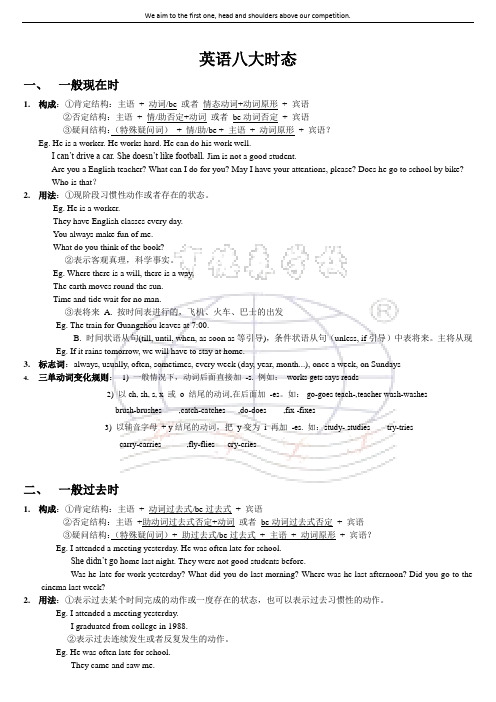
5.不规则变化
六、过去进行时
1.构成:①肯定结构:主语+was/were + doing+ (宾语)
②否定结构:主语+was/were not + doing+ (宾语)
④不能用于进行时的动词:A.表示感觉的(feel, smell, sound, taste)
Eg. The plan sounds good.
B.表示感情、拥有关系、状态或思想的动词:agree, believe, belong, contain, hate, hear, like, love, mind, possess, seem, understand, want等
Eg. I wasgoingto leave when it began to rain.
He looked as if he was about to burst into tears.
③was/were to do和was/were doing:
Eg. I was seeing off my sister at the station the next day.
4)重读闭音节,双写词尾辅音字母加ed.如: preferred(重读在fer前); admittedstopped
三、一般将来时
1.结构:①肯定结构:主语+be going to + do或者will/shall + do+宾语
②否定结构:主语+be not going to + do或者will/shall not + do+宾语
He is not going to play basketball this weekend.
英语的8种时态
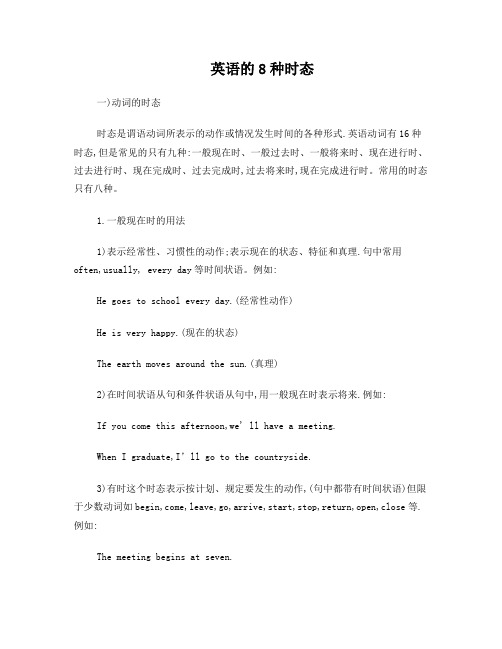
英语的8种时态一)动词的时态时态是谓语动词所表示的动作或情况发生时间的各种形式.英语动词有16种时态,但是常见的只有九种:一般现在时、一般过去时、一般将来时、现在进行时、过去进行时、现在完成时、过去完成时,过去将来时,现在完成进行时。
常用的时态只有八种。
1.一般现在时的用法1)表示经常性、习惯性的动作;表示现在的状态、特征和真理.句中常用often,usually, every day等时间状语。
例如:He goes to school every day.(经常性动作)He is very happy.(现在的状态)The earth moves around the sun.(真理)2)在时间状语从句和条件状语从句中,用一般现在时表示将来.例如:If you come this afternoon,we' ll have a meeting.When I graduate,I’ll go to the countryside.3)有时这个时态表示按计划、规定要发生的动作,(句中都带有时间状语)但限于少数动词如begin,come,leave,go,arrive,start,stop,return,open,close等.例如:The meeting begins at seven.The train starts at nine in the morning.4)表示状态和感觉的动词,如be,like,hate,think,remember,find,sound等常用一般现在时.例如:I like English very much.The story sounds very interesting.5)书报的标题,小说等情节介绍常用一般现在时.2.一般过去时的用法l)表示过去某时间发生的事、存在的状态或过去反复发生的动作.He saw Mr Wang yesterday.He worked in a factory in 19862)表示过去经常发生的动作,也可用“used to”和“would +动词原形”。
英语时态8种基本时态

英语时态8种基本时态
英语时态:8种基本时态
引言:
英语是世界上最广泛使用的语言之一,掌握英语的时态对于正确表达和理解英语句子至关重要。
英语时态可以用来表示动作的发生时间、持续时间和完成程度。
本文将介绍英语中的8种基本时态,分别是一般现在时、一般过去时、一般将来时、现在进行时、过去进行时、将来进行时、现在完成时和过去完成时。
一、一般现在时(Simple Present Tense):
一般现在时是用来描述经常性的、普遍性的事实或习惯动作。
句子中的主语与动词原形保持一致。
例如:“I eat breakfast every morning”(我每天早上吃早餐)。
二、一般过去时(Simple Past Tense):
一般过去时用来描述过去发生的具体事情或经历。
常用的过去式形式是动词的过去式。
例如:“She watched a movie last night”(她昨晚看了一部电影)。
三、一般将来时(Simple Future Tense):
一般将来时用于表示将来发生的动作或事件。
常用的表达方式是使用助动词\。
英语时态8种基本时态讲解

英语时态8种基本时态讲解一.概念:英语中表示不同时间发生的动作或存在的状态,需用不同的动词形式表示,这种不同的动词形式称为时态。
二.种类:(基本时态)一般现在时一般过去时现在进行时过去进行时一般将来时过去将来时现在完成时过去完成时三.用法:1)一般现在时表示经常发生或习惯性的动作或状态及客观现实和普遍真理。
一般现在时常以动词原形表示,但当主语是第三人称单数时,动词词尾加-s或-es。
2)句型结构:主语+V.(包括be动词)+宾语+…She is an engineer.He has breakfast at 6:00every day.3)注意:a)一般现在时通常与always , often , usually , every day , sometimes , once aweek 等时间状语连用。
I always watch TV at 8:00 in the evening .They go home once a week .We usually do our homework at home .b)表客观现实或普遍真理。
The sun always rises in the east .The light travels faster than the sound .c)表永远性的动作或状态。
He lives in the country .例句:我们每天晚上九点做作业。
我在早上七点半起床。
他每天七点去上班。
我们经常下午打篮球。
他喜欢音乐。
地球围绕太阳转。
火车六点出发。
1)一般过去时表示发生在过去的动作或存在的状态,通常与表示过去的时间状语yesterday, last night ,some years ago, in 1990,in those days.等连用。
I was a student 6years ago.I went to Beijing last year.They saw a film last night .2)句型结构:主语+V.过去时+宾语+…例句:昨天他很忙。
英语八大时态讲解

英语八大时态讲解
英语的八大时态包括:一般现在时,一般过去时,现在进行时,过去进行时,一般将来时,过去将来时,现在完成时,过去完成时。
以下是每个时态的详细讲解:
一般现在时:表示经常性或习惯性动作,常与表频度的时间状语连用,如She often speaks English。
也可以表示现在的状态、特征、职业、能力、感觉等,如He seems to feel a bit down today。
此外,它还可以表示真理、客观存在、科学事实或用于格言警句中,如Shanghai lies in the east of China。
一般过去时:表示发生在过去的动作或存在的状态,通常与表示过去的时间状语yesterday,last night,some years ago,in 1990等连用。
现在进行时:表示正在进行的动作或存在的状态,如I am studying now。
过去进行时:表示在过去某个时间点正在进行的动作或存在的状态,如She was studying at 8 o’clock yesterday。
一般将来时:表示将来要发生的动作或存在的状态,如I will go to school tomorrow。
过去将来时:表示在过去某个时间点看来将要发生的动作或存在的状态,如She said she would come to see me the next day。
现在完成时:表示过去发生的动作持续到现在,并可能继续下去,如I have studied English for 5 years。
过去完成时:表示在过去某个时间点之前已经完成的动作或存在的状态,如He said he had finished his homework。
英语八大时态基本句型及例句

英语八大时态基本句型及例句英语中有八种基本时态,包括:现在简单时态、现在进行时态、现在完成时态、过去简单时态、过去进行时态、过去完成时态、将来简单时态和将来完成时态。
以下是每种时态的基本句型及例句:1. 现在简单时态(Present Simple Tense)基本句型:主语 + 动词原形(第三人称单数加s)例句:My sister reads books every day.(我姐姐每天都读书。
) 2. 现在进行时态(Present Continuous Tense)基本句型:主语 + am/is/are + 现在分词例句:I am studying English now.(我正在学英语。
)3. 现在完成时态(Present Perfect Tense)基本句型:主语 + have/has + 过去分词例句:She has visited many countries.(她去过很多国家。
) 4. 过去简单时态(Past Simple Tense)基本句型:主语 + 过去式动词例句:He went to the beach last weekend.(上周末他去了海滩。
)5. 过去进行时态(Past Continuous Tense)基本句型:主语 + was/were + 现在分词例句:They were playing basketball when it started to rain.(当下雨时他们正在打篮球。
)6. 过去完成时态(Past Perfect Tense)基本句型:主语 + had + 过去分词例句:I had finished my homework before my friends arrived.(朋友到达之前我已经完成了作业。
)7. 将来简单时态(Future Simple Tense)基本句型:主语 + will + 动词原形例句:I will help you with your project tomorrow.(我明天会帮你做项目。
初中英语八大时态讲解_图文

2 have been to+地点,表示“去过某地”
。(人已回) I have been to Europe. (I am not in Europe now.)
3 have been in+地点+时间段,表示“在/ 来某地多久”。
I have been in Europe for three weeks. (I am now still in Europe .)
go there get home open close get to know borrow buy
be there be home be open be closed know keep have
1.The film began 5 The film_h_a_s b_e_en_o_n__ for 5
• 9.They got to know 10 They_h_av_e_k_n_o_w_n__since 10
years ago.
years ago.
• 10.I borrowed the book a I_h_a_v_e _k_e_p_t _the book for a
week ago.
week.
二、一般过去时
1.用法:过去的动作或状态。
2.标志词:
yesterday, the day before yesterday,
three days ago, last night/week/month…,in the past;just
now=a moment ago
例题
Li Ming didn’t understand what American people
4.He joined the club 3 He__h_as_b_e_en_i_n__the club for
英语时态讲解课件.ppt
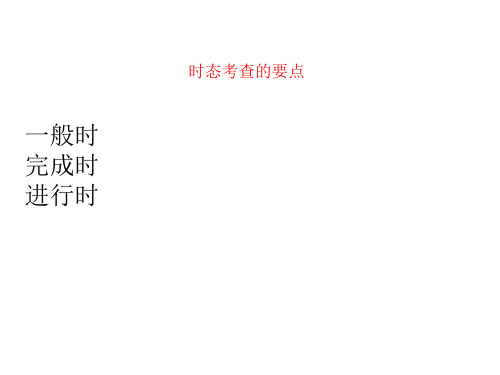
(2)现在完成时表示过去已经开始,持续到现在,也许还会持续下 去的动作或状态。可以和表示从过去某一时刻延续到现在(包括现 在在内)的一段时间的状语连用。 如:for和since,以及 so far, now, today, this week(month, year) 等。
① I haven’t seen her these days. ② She has learnt English for 3 years. ③ They have lived here since 1990. ④ What has happened to the USA in the last 350 years? 注意:表示短暂时间动作的词,如come, go, die, marry, buy等的完 成时不能与for, since等表示一段时间的短语连用。
-ing形式 going, looking
writing, taking
get, sit, put, run, getting, sitting,
begin
running,
beginning
现在完成时
1.现在完成时的构成:助动词have (has) + 动词的过去分词(done)
2.现在完成时的用法: (1)现在完成时表示过去发生或已经完成的某一动作对现在造成 的影响或结果。通常与表示包括现在在内的时间副词just,already, before, yet, never, ever ,up till now 等状语连用。 特别注意的是in the past/last+一段时间。 例如:
A. had met B. have met C. met
D. meet
答案B ;首先本题后句强调对现在的影响,我知道她的模样,你不 用描述。再次,several times告知为反复发生的动作,因此用现在 完成时。
英语时态8种基本时态结构

英语时态8种基本时态结构英语中有8种基本时态结构:简单现在时、进行时、完成时、过去时、过去进行时、过去完成时、将来时和将来完成时。
1. 简单现在时 (Simple Present)简单现在时用来表示经常性、习惯性或普遍真相的动作或状态。
在句子中,主语是第三人称单数,谓语动词要加上“-s”或“-es”。
例如:- He goes to work every day. (他每天上班。
)- Cats like to chase mice. (猫喜欢追逐老鼠。
)- The sun rises in the east. (太阳从东方升起。
)2. 进行时 (Present Continuous)进行时用来表示目前正在进行的动作或状态。
在句子中,谓语动词由“be”动词的不同形式加上动词的现在分词构成。
例如:- She is watching TV now. (她现在正在看电视。
)- We are studying for the exam. (我们正在为考试学习。
)- They are playing soccer in the park. (他们在公园里踢足球。
)3. 完成时 (Present Perfect)完成时用来表示过去已经发生但与现在相关的动作或状态。
在句子中,谓语动词由“have/has”+过去分词构成。
例如:- I have finished my homework. (我已经完成作业。
)- She has lived in London for five years. (她在伦敦住了五年。
)- They have traveled to many countries. (他们去过许多国家。
)4. 过去时 (Simple Past)过去时用来表示过去一些时间发生的动作或状态。
在句子中,谓语动词用动词的过去式形式。
例如:- I visited my grandparents last weekend. (上周末我去看望了我的祖父母。
英语时态8种基本时态讲解
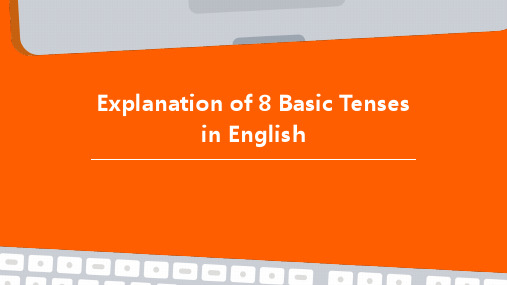
Past future continuous tense
Summary
This tense is used to describe an action in the past that was ongoing and would
continue into the future.
Example
"He knew he would be late, so he started walking faster."
Past future perfect continuous tense
Summary
01
This tense is used to show an action in the past that had
been ongoing before another action in the future.
02
Past tense
Past continuous tense
表示过去某个时间正在进行的动作
This tense is used to show an action that was ongoing in the past. It is formed by using "was" or "were" with the -ing form of the verb. Example: "I was walking to the store when I saw my friend."
before their boss arrived.
谢谢观看
Examples
"I have been studying", "They have been playing".
高中英语16种英语时态讲解(共43张PPT)
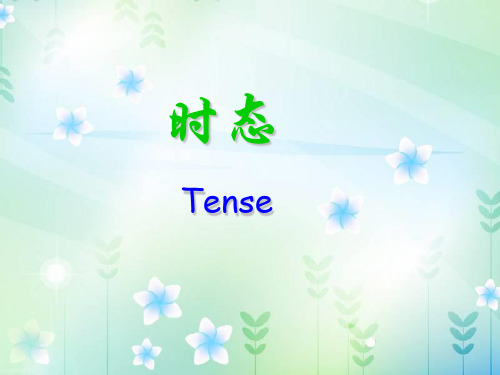
• Someone is knocking at the door. I’ll go and open it.
8
五、现在进行时态
现在进行时的基本用法
形式: am/is/are + doing
现在进行时的基本用法
用法3: 表示最近的将来一定的安排. 通常含有“计划”, “安排做”之意.
• I am taking a makeup test tomorrow. • — what are you doing on Saturday night?
— I’m doing some shopping with Jane. 用法4: 常与always, forever, continually, constantly 等连用,表示抱怨,厌烦, 不合情理或使人不愉快的事.
一般现在时的基本用法
形式:
do 或does(第三人 称单数)
用法1: 表示经常发生的习惯性的动作或者存在的状态.
• He often goes to the gym.
• I like the rice for dinner.
• He doesn’t work hand.
此用法常与一些表示动作频率的时间副词连用(副词放在be动词之 后, 实义动词之前).
3
二、一般现在时态
一般现在时的基本用法
用法2: 表示不受时间限制的事实陈述或客观性的真理. • The earth moves around the sun. • The sun rises in the east and sets in the west. • Knowledge is power.
八种常用时态讲解
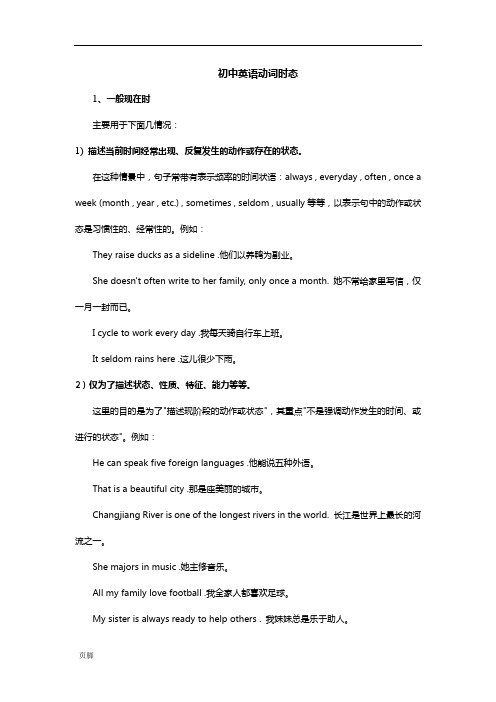
初中英语动词时态1、一般现在时主要用于下面几情况:1) 描述当前时间经常出现、反复发生的动作或存在的状态。
在这种情景中,句子常带有表示频率的时间状语:always , everyday , often , once a week (month , year , etc.) , sometimes , seldom , usually等等,以表示句中的动作或状态是习惯性的、经常性的。
例如:They raise ducks as a sideline .他们以养鸭为副业。
She doesn't often write to her family, only once a month. 她不常给家里写信,仅一月一封而已。
I cycle to work every day .我每天骑自行车上班。
It seldom rains here .这儿很少下雨。
2)仅为了描述状态、性质、特征、能力等等。
这里的目的是为了"描述现阶段的动作或状态",其重点"不是强调动作发生的时间、或进行的状态"。
例如:He can speak five foreign languages .他能说五种外语。
That is a beautiful city .那是座美丽的城市。
Changjiang River is one of the longest rivers in the world. 长江是世界上最长的河流之一。
She majors in music .她主修音乐。
All my family love football .我全家人都喜欢足球。
My sister is always ready to help others . 我妹妹总是乐于助人。
3) 述客观事实、客观真理。
顾名思义,客观的情况是"没有时间概念"的;也"不会在意动作进行的状态"。
- 1、下载文档前请自行甄别文档内容的完整性,平台不提供额外的编辑、内容补充、找答案等附加服务。
- 2、"仅部分预览"的文档,不可在线预览部分如存在完整性等问题,可反馈申请退款(可完整预览的文档不适用该条件!)。
- 3、如文档侵犯您的权益,请联系客服反馈,我们会尽快为您处理(人工客服工作时间:9:00-18:30)。
• 句型结构:主语+will/shall+V.原形 +…(第一人称用shall) • I shall go to Shanghai tomorrow. • They will have a meeting next week. • ----She will be 20 years old.
be(am, is, are)going to+动词原形 They are going to have a meeting next Sunday. be going to 和will的区别 be going to表示近期、眼下就要发生的事情, will 表示的将来时间则较远一些。 • He is going to write a letter tonight. • He will write a book one • • • •
• 注意 • 含有终止意义或暂短意义的动词不能与 for, since 引导的一般时间状语连用。(buy, begin, die, come, go , join, leave 等) • I have had a book for 3 years. • I have bought a book for 3 day. (wrong) • He has been in the army for 3 years. • He have joined the army for 3 years. (wrong)
英语8种基本时态讲解
• 一.概念:英语中表示不同时 间发生的动作或存在的状态, 需用不同的动词形式表示,这 种不同的动词形式类:(基本时态) 一般现在时 一般过去时 现在进行时 过去进行时 一般将来时 过去将来时 现在完成时 过去完成时
1.一般现在时: • 句型结构:主语+V.(包括be动词)+ 宾语+其他成分 • 当主语是第三人称单数时,动词词尾加s或-es
• 8.过去完成时 • 表示动作发生在过去某一时间之前 已经完成的动作或状态, 强调 “过去的过去”, 常与 by the time, by the end of…,before , by 等引导时 间的状语连用。
• 基本结构 主语+ had + 动词过去分 词 + 其他成分 • When I got to the cinema yesterday the film had begun already. • He had learned English before he came here.
• • • •
c)----He likes music. ----He doesn’t like music. ----Does he like music? ----Yes ,he does./ No, he doesn’t .
• 2.一般过去时 • 表示发生在过去的动作或存在的状态, 通常与表示过去的时间状语如yesterday, last night ,some years ago, in 1990,in those days.等连用。 • I was a student 6years ago. • I went to Beijing last year.
• be going to含有“打算,准备”的 意思,而will则没有这个意思, • She is going to lend us her book. • He will be here in half an hour.
• be about to+V.原形(意为马上做 某事,在时间上指最近的将来) • I am about to leave school. • 不能与表示时间的副词连用。 • They are about to set out.(√) • They are about to set out soon.(×)
• 现在完成时与一般过去时的区别: • 1)现在完成时侧重于对现在的影响;而 一般过去时侧重于某一动作发生在过去 某个时间或某段时间。即现在完成时侧
重于现在的结果,而一般过去时侧重于
动作发生的时间。例如:
• I have seen the film. • 我看过这部电影。(现在我仍记得 电影的内容) • I saw the film three days ago. • 三天前我看了这部电影。(强调是 三天前,而不是别的什么时候看的 电影)
• 6 .过去进行时
• 表示过去某一时刻或某阶段时间正 在进行的动作, 通常与 at 6:00 yesterday, at this/ that time yesterday, when 引导的时间状语等连用。
• 基本结构 主语+be (was/were) +ving +其他成分 • It was raining at 7:00 the day before yesterday. • They were building a reservoir at this time last winter.
• 注意: • 一般现在时通常与always , often , usually 等频度副词以及 every day , sometimes , once a week 等时间状 语连用。 • I always watch TV at 8:00 in the evening . • They go home once a week .
• • • • •
4)动词过去式变化规则。 a)一般情况下的词加-ed. work---worked call----called b)以不发音的字母e结尾的单词直接加-d . live----lived change----changed smoke---smoked die----died graduate---graduated drive----drove
• f)动词不规则变化: • do----did go----went come----came run----ran • begin----began drink----drank keep---kept • cut----cut set----set let----let
• 3.一般将来时 • 表示将来发生的动作或存在的状态, 常与表将来的时间状语tomorrow, the day after tomorrow, next Sunday, soon, in a few days等连用。
• 7.现在完成时 • 表示过去发生的动作对现在造成的 影响。 • I’ve finished this work. • He has ever been to Australia.
• 表示过去某时间已经开始一直持续 到现在的动作或状态通常与下列时 间状语连用 up to now, in the past, recently, by… , for 5 years, since 1994, so far, already, yet, ever, just…
• 基本结构 主语+ have/has + P.P(动 词过去分词) • I have already read this book. • Have you read…? • Yes, I have. No, I haven’t. • What have you read?
• • • •
过去分词的不规则变化 do did done go went gone eat ate eaten come came come have had had see saw seen
• 否定句和疑问句。 • b)----We get up at 7:30 in the morning . -----We don’t get up at 7:30 in the morning . • -----Do you get up at 7:30 in the morning ? • -----Yes, we do. / No, we don’t.
• • • • • •
第三人称单数变化形式。 a)一般情况动词在词尾加-s . come---comes speak---speaks b)以o, s, x, ch, sh结尾的单词在词后加es. do---does go---goes finish---finishes fix---fixes pass---passes watch---watches
• c)以辅音字母+y结尾的单词,变y 为i加-ed. • study----studied carry----carried cry----cried try----tried • d)以元音字母+y结尾的单词直接 加-ed. • play----played stay----stayed
• e)以元音+辅音结尾的单词应先双 写这个辅音字母然后再加-ed. • stop----stopped plan----planned pat----patted
• b)----He smoked last year. • -----He didn’t smoke last year. • -----Did he smoke last year? • -----Yes ,he did ./No ,he didn’t.
• • • •
c)----He joined the army in 1990. -----He didn’t joined the army in 1990. -----Did he join the army in 1990? -----Yes ,he did ./No ,he didn’t.
4.过去将来时 • 过去将来时是立足于过去某时,从 过去的观点看将要发生的动作或状 态。主要用于宾语从句中。
• 基本结构:主语+would/should / was/were going to +V.原形+… • He said that he would have a meeting next week. • They said we should leave school tomorrow.
